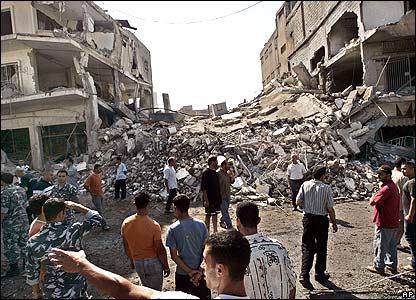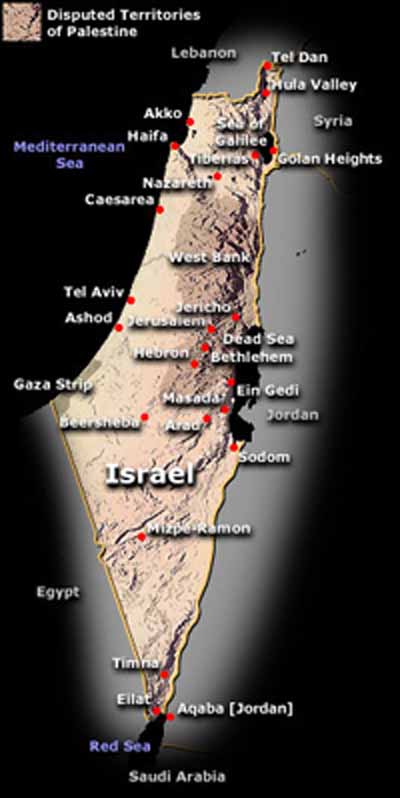Key Terms :
The Israeli-Palestinian Conflict
The Israeli-Palestinian Conflict
See a descriptive map
of the disputed territory
Information
taken from The Road to Peace, csmonitor.com
A plan developed by the US, the United Nations, the European Union, and Russia that calls for the establishment of a permanent Palestinian state and a full settlement of the Israeli-Palestinian conflict by 2005. The seven-page plan, discussed in broad strokes throughout 2002, was delivered to both Israeli and Palestinian officials after the Palestinian Authority appointed Mahmoud Abbas as its first prime minister on April 29, 2003. By the end of May, both sides had endorsed it – though the Israelis listed 14 concerns.
Right-of-return:
When Israel was created in 1948, hundreds of thousands of Palestinians fled or were evicted from the new state. Many wound up in refugee camps in neighboring Arab states. They passed down to new generations their dreams of returning, and in some cases even the actual deeds to property. Palestinian leaders have insisted that the "dispossessed" have a right to return to their former homes, while Israel has steadfastly refused to consider the issue. Such an influx of Palestinians would dilute the Jewish population within Israel, and challenge its identity as a Jewish state. One suggested compromise: allowing a token number to return and compensating the rest.
Jewish settlements:
In the 1967 war, Israel defeated a second Arab invasion and retained control of the Palestinian territories remaining after the 1948 war. Israel encouraged Jewish settlers to build on this newly occupied land. Many of the settlers were immigrants pouring in from the former Soviet Union after its collapse. Settlements became an expedient way of integrating the poor arrivals into the Israeli economy. However, the Palestinians have never accepted the post-1967 borders, and see the 400,000 settlers as encroaching on their land. The settlements have become extremely disruptive to the peace process, not only as frequent scenes of violence, but as sticking points in any potential border negotiations.
Intifada:
Literally meaning "uprising," intifada is the name given to two widespread Palestinian resistance movements. The first intifada started in 1987 and mostly involved Palestinian youth throwing rocks at Israeli troops, who sometimes shot back with deadly force. Badly outgunned, many more Palestinians were killed than Israelis. The second intifada began in 2000 as a hopeful phase in the peace process began to lose momentum and Israeli politician Ariel Sharon made a provocative visit to the al-Aqsa Mosque. This time, suicide bombers are the weapon of choice, resulting in a much bloodier conflict for the Israelis.
Palestinian Authority:
The Oslo Accords created a limited Palestinian self-government with Yasser Arafat at its head. The PA has jurisdiction in much of the occupied territories of the West Bank and Gaza Strip. While the PA is not an internationally recognized sovereign state able to conduct foreign policy, it does have substantial domestic powers including its own armed police force. The PA headquarters are in the West Bank city of Ramallah.
The Oslo Accords:
In 1993, Israeli Prime Minister Yitzhak Rabin and Palestinian leader Yasser Arafat arrived at this landmark agreement. Known as "land for peace," Israel agreed to withdraw troops from Gaza and parts of the West Bank, where Palestinians would be given self-rule. In exchange, the Palestinian Liberation Organization agreed to recognize Israel and renounce terrorism. The Accords left the Jewish settlements and all highways in Israeli control, and did not resolve the issue of Jerusalem. However, they became the foundation for the peace process. Arafat gained leadership over the new Palestinian Authority government and new status as a peace partner in the eyes of Israel and the US. Rabin was later assassinated by a Jewish militant.
The Wye River Accord:
The 1993 Oslo Accords set a five-year timetable for the implementation of many key issues only agreed upon in principle. In order to hash out the details before that deadline, Israeli Prime Minister Benjamin Netanyahu and Palestinian Authority leader Yasser Arafat met in Maryland in 1998. The perennial obstacles of Jewish settlements and Palestinian terror attacks hampered the talks. However a final deal was reached. The Palestinians agreed to revoke anti-Israeli provisions in the PLO charter and to arrest alleged terrorists; the Israelis agreed to an additional 13 percent pullback from the West Bank and to free hundreds of Palestinian prisoners.
The Taba talks:
Named for a town in Egypt, the Taba talks were a failed last-ditch effort by President Bill Clinton to broker an historic peace agreement between Palestinian leader Yasser Arafat and Iraeli Prime Minister Ehud Barak. Months earlier at a Camp David summit, the two sides came extremely close to a final peace settlement between the two parties. Barak was more flexible than past Israeli leaders to put "non-negotiable" topics on the table, but his all-or-nothing approach is said to have spooked Arafat. The failure to reach agreement left deep bitterness on both sides. The Israelis claim that Barak offered Arafat the moon and he still wasn't satisfied, insisting on an unrealistic right-of-return. The Palestinians say momentum for a deal with Barak was lost when he allowed Ariel Sharon to visit the Al Aqsa mosque.
